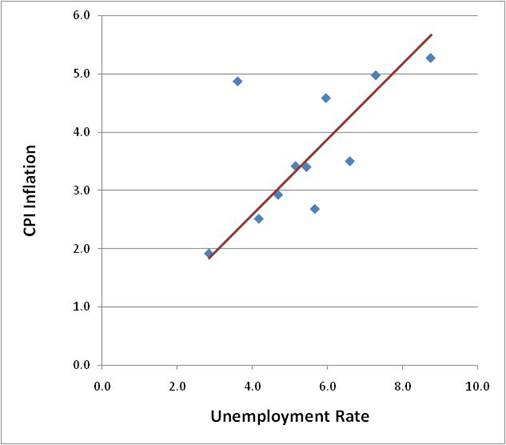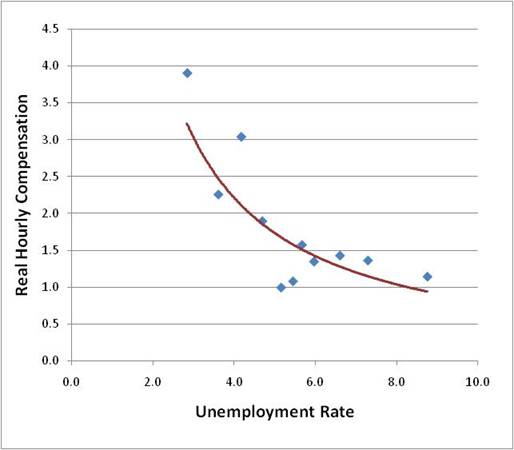Home › Forums › Financial Markets/Economics › Inflation, interest rates, and the Fed
- This topic has 175 replies, 13 voices, and was last updated 15 years, 2 months ago by
patientrenter.
-
AuthorPosts
-
June 16, 2010 at 11:54 AM #566909June 16, 2010 at 12:00 PM #565921
 Rich ToscanoKeymaster
Rich ToscanoKeymasterActually the Hussman article from which I quoted has more good stuff, including some graphs… whole thing is here but this (along with what I quoted above) is the meat:
The charts below are based on data since 1947. Monthly unemployment rates were sorted from highest to lowest, divided into equal groups, and the average unemployment rate and year-over-year CPI inflation rate were plotted for each group. What we observe in the data is strikingly opposite to the standard (mis)interpretation of the Phillips Curve. Indeed, higher unemployment is generally associated with higher, not lower general price inflation.

Contrast this with what I would assert is the real Phillips curve, which is simply a statement about labor scarcity. It says, in a very unadorned way, that when labor is scarce (low unemployment), the price of labor tends to rise relative to the price of other things (thus we observe real wage inflation). In contrast, when labor is plentiful (high unemployment), the price of labor tends to stagnate relative to the price of other things (real wages stagnate). Since productivity growth tends to be positive over time, it turns out that real wages actually fall on a productivity-adjusted basis when unemployment is high. From this perspective, it is no surprise that real wages fell by 1.6% in 2009, even as reported productivity grew.
 June 16, 2010 at 12:00 PM #566019
June 16, 2010 at 12:00 PM #566019 Rich ToscanoKeymaster
Rich ToscanoKeymasterActually the Hussman article from which I quoted has more good stuff, including some graphs… whole thing is here but this (along with what I quoted above) is the meat:
The charts below are based on data since 1947. Monthly unemployment rates were sorted from highest to lowest, divided into equal groups, and the average unemployment rate and year-over-year CPI inflation rate were plotted for each group. What we observe in the data is strikingly opposite to the standard (mis)interpretation of the Phillips Curve. Indeed, higher unemployment is generally associated with higher, not lower general price inflation.

Contrast this with what I would assert is the real Phillips curve, which is simply a statement about labor scarcity. It says, in a very unadorned way, that when labor is scarce (low unemployment), the price of labor tends to rise relative to the price of other things (thus we observe real wage inflation). In contrast, when labor is plentiful (high unemployment), the price of labor tends to stagnate relative to the price of other things (real wages stagnate). Since productivity growth tends to be positive over time, it turns out that real wages actually fall on a productivity-adjusted basis when unemployment is high. From this perspective, it is no surprise that real wages fell by 1.6% in 2009, even as reported productivity grew.
 June 16, 2010 at 12:00 PM #566527
June 16, 2010 at 12:00 PM #566527 Rich ToscanoKeymaster
Rich ToscanoKeymasterActually the Hussman article from which I quoted has more good stuff, including some graphs… whole thing is here but this (along with what I quoted above) is the meat:
The charts below are based on data since 1947. Monthly unemployment rates were sorted from highest to lowest, divided into equal groups, and the average unemployment rate and year-over-year CPI inflation rate were plotted for each group. What we observe in the data is strikingly opposite to the standard (mis)interpretation of the Phillips Curve. Indeed, higher unemployment is generally associated with higher, not lower general price inflation.

Contrast this with what I would assert is the real Phillips curve, which is simply a statement about labor scarcity. It says, in a very unadorned way, that when labor is scarce (low unemployment), the price of labor tends to rise relative to the price of other things (thus we observe real wage inflation). In contrast, when labor is plentiful (high unemployment), the price of labor tends to stagnate relative to the price of other things (real wages stagnate). Since productivity growth tends to be positive over time, it turns out that real wages actually fall on a productivity-adjusted basis when unemployment is high. From this perspective, it is no surprise that real wages fell by 1.6% in 2009, even as reported productivity grew.
 June 16, 2010 at 12:00 PM #566636
June 16, 2010 at 12:00 PM #566636 Rich ToscanoKeymaster
Rich ToscanoKeymasterActually the Hussman article from which I quoted has more good stuff, including some graphs… whole thing is here but this (along with what I quoted above) is the meat:
The charts below are based on data since 1947. Monthly unemployment rates were sorted from highest to lowest, divided into equal groups, and the average unemployment rate and year-over-year CPI inflation rate were plotted for each group. What we observe in the data is strikingly opposite to the standard (mis)interpretation of the Phillips Curve. Indeed, higher unemployment is generally associated with higher, not lower general price inflation.

Contrast this with what I would assert is the real Phillips curve, which is simply a statement about labor scarcity. It says, in a very unadorned way, that when labor is scarce (low unemployment), the price of labor tends to rise relative to the price of other things (thus we observe real wage inflation). In contrast, when labor is plentiful (high unemployment), the price of labor tends to stagnate relative to the price of other things (real wages stagnate). Since productivity growth tends to be positive over time, it turns out that real wages actually fall on a productivity-adjusted basis when unemployment is high. From this perspective, it is no surprise that real wages fell by 1.6% in 2009, even as reported productivity grew.
 June 16, 2010 at 12:00 PM #566924
June 16, 2010 at 12:00 PM #566924 Rich ToscanoKeymaster
Rich ToscanoKeymasterActually the Hussman article from which I quoted has more good stuff, including some graphs… whole thing is here but this (along with what I quoted above) is the meat:
The charts below are based on data since 1947. Monthly unemployment rates were sorted from highest to lowest, divided into equal groups, and the average unemployment rate and year-over-year CPI inflation rate were plotted for each group. What we observe in the data is strikingly opposite to the standard (mis)interpretation of the Phillips Curve. Indeed, higher unemployment is generally associated with higher, not lower general price inflation.

Contrast this with what I would assert is the real Phillips curve, which is simply a statement about labor scarcity. It says, in a very unadorned way, that when labor is scarce (low unemployment), the price of labor tends to rise relative to the price of other things (thus we observe real wage inflation). In contrast, when labor is plentiful (high unemployment), the price of labor tends to stagnate relative to the price of other things (real wages stagnate). Since productivity growth tends to be positive over time, it turns out that real wages actually fall on a productivity-adjusted basis when unemployment is high. From this perspective, it is no surprise that real wages fell by 1.6% in 2009, even as reported productivity grew.
 June 16, 2010 at 12:23 PM #565936
June 16, 2010 at 12:23 PM #565936XBoxBoy
Participant[quote=Rich Toscano quoting John Hussman]In any event, unemployment emphatically does not prevent the inflationary consequences of reckless creation of government liabilities.”[/quote]
If I read Hussman’s view correctly, he’s only saying that if the govt wants, it can always create inflation. (Which is pretty much Bernanke’s view as well) So, that begs the question, is it your view that the govt will print enough money to cause inflation? (And I guess what measure will we use is another issue.)
While I could easily be wrong, I suspect they won’t print enough to cause significant inflation for three reasons.
1) While they are doing all they can to reinflate the various bubbles, they will stop (and put on brakes if necessary) as soon as the bubbles appear to be reinflated. (This is because although they don’t admit it, I bet they are scared of bubbles getting out of hand after the last couple of years)
2) To cause inflation they have to print enough money to compensate for all the lost money due to defaulting loans, and then some more.
3) Like most experts, the fed overestimates their abilities and powers. We see that today as they talk of how the recovery is progressing and there won’t be a double dip. Thus they are currently coming off the money printing throttle. If they are wrong, that’s all the more money they will have to print just to fight deflation.
I will grant you however, that if they get particularly out of hand they could create inflation. I just don’t think that they’ll get that out of hand.
XBoxBoy
June 16, 2010 at 12:23 PM #566034XBoxBoy
Participant[quote=Rich Toscano quoting John Hussman]In any event, unemployment emphatically does not prevent the inflationary consequences of reckless creation of government liabilities.”[/quote]
If I read Hussman’s view correctly, he’s only saying that if the govt wants, it can always create inflation. (Which is pretty much Bernanke’s view as well) So, that begs the question, is it your view that the govt will print enough money to cause inflation? (And I guess what measure will we use is another issue.)
While I could easily be wrong, I suspect they won’t print enough to cause significant inflation for three reasons.
1) While they are doing all they can to reinflate the various bubbles, they will stop (and put on brakes if necessary) as soon as the bubbles appear to be reinflated. (This is because although they don’t admit it, I bet they are scared of bubbles getting out of hand after the last couple of years)
2) To cause inflation they have to print enough money to compensate for all the lost money due to defaulting loans, and then some more.
3) Like most experts, the fed overestimates their abilities and powers. We see that today as they talk of how the recovery is progressing and there won’t be a double dip. Thus they are currently coming off the money printing throttle. If they are wrong, that’s all the more money they will have to print just to fight deflation.
I will grant you however, that if they get particularly out of hand they could create inflation. I just don’t think that they’ll get that out of hand.
XBoxBoy
June 16, 2010 at 12:23 PM #566542XBoxBoy
Participant[quote=Rich Toscano quoting John Hussman]In any event, unemployment emphatically does not prevent the inflationary consequences of reckless creation of government liabilities.”[/quote]
If I read Hussman’s view correctly, he’s only saying that if the govt wants, it can always create inflation. (Which is pretty much Bernanke’s view as well) So, that begs the question, is it your view that the govt will print enough money to cause inflation? (And I guess what measure will we use is another issue.)
While I could easily be wrong, I suspect they won’t print enough to cause significant inflation for three reasons.
1) While they are doing all they can to reinflate the various bubbles, they will stop (and put on brakes if necessary) as soon as the bubbles appear to be reinflated. (This is because although they don’t admit it, I bet they are scared of bubbles getting out of hand after the last couple of years)
2) To cause inflation they have to print enough money to compensate for all the lost money due to defaulting loans, and then some more.
3) Like most experts, the fed overestimates their abilities and powers. We see that today as they talk of how the recovery is progressing and there won’t be a double dip. Thus they are currently coming off the money printing throttle. If they are wrong, that’s all the more money they will have to print just to fight deflation.
I will grant you however, that if they get particularly out of hand they could create inflation. I just don’t think that they’ll get that out of hand.
XBoxBoy
June 16, 2010 at 12:23 PM #566651XBoxBoy
Participant[quote=Rich Toscano quoting John Hussman]In any event, unemployment emphatically does not prevent the inflationary consequences of reckless creation of government liabilities.”[/quote]
If I read Hussman’s view correctly, he’s only saying that if the govt wants, it can always create inflation. (Which is pretty much Bernanke’s view as well) So, that begs the question, is it your view that the govt will print enough money to cause inflation? (And I guess what measure will we use is another issue.)
While I could easily be wrong, I suspect they won’t print enough to cause significant inflation for three reasons.
1) While they are doing all they can to reinflate the various bubbles, they will stop (and put on brakes if necessary) as soon as the bubbles appear to be reinflated. (This is because although they don’t admit it, I bet they are scared of bubbles getting out of hand after the last couple of years)
2) To cause inflation they have to print enough money to compensate for all the lost money due to defaulting loans, and then some more.
3) Like most experts, the fed overestimates their abilities and powers. We see that today as they talk of how the recovery is progressing and there won’t be a double dip. Thus they are currently coming off the money printing throttle. If they are wrong, that’s all the more money they will have to print just to fight deflation.
I will grant you however, that if they get particularly out of hand they could create inflation. I just don’t think that they’ll get that out of hand.
XBoxBoy
June 16, 2010 at 12:23 PM #566939XBoxBoy
Participant[quote=Rich Toscano quoting John Hussman]In any event, unemployment emphatically does not prevent the inflationary consequences of reckless creation of government liabilities.”[/quote]
If I read Hussman’s view correctly, he’s only saying that if the govt wants, it can always create inflation. (Which is pretty much Bernanke’s view as well) So, that begs the question, is it your view that the govt will print enough money to cause inflation? (And I guess what measure will we use is another issue.)
While I could easily be wrong, I suspect they won’t print enough to cause significant inflation for three reasons.
1) While they are doing all they can to reinflate the various bubbles, they will stop (and put on brakes if necessary) as soon as the bubbles appear to be reinflated. (This is because although they don’t admit it, I bet they are scared of bubbles getting out of hand after the last couple of years)
2) To cause inflation they have to print enough money to compensate for all the lost money due to defaulting loans, and then some more.
3) Like most experts, the fed overestimates their abilities and powers. We see that today as they talk of how the recovery is progressing and there won’t be a double dip. Thus they are currently coming off the money printing throttle. If they are wrong, that’s all the more money they will have to print just to fight deflation.
I will grant you however, that if they get particularly out of hand they could create inflation. I just don’t think that they’ll get that out of hand.
XBoxBoy
June 16, 2010 at 12:44 PM #565951Nor-LA-SD-guy
ParticipantIn the 70’s there were still large pools of union workers (mostly gone now after the 80’s), I think in the absents of full employment it would be very hard today to create significant inflation.
To get an Idea what a large unionized work force can do, just look at China over the last month, 30% inflation may not cure completely their housing bubble, but it will sure help some pay the bills.
June 16, 2010 at 12:44 PM #566049Nor-LA-SD-guy
ParticipantIn the 70’s there were still large pools of union workers (mostly gone now after the 80’s), I think in the absents of full employment it would be very hard today to create significant inflation.
To get an Idea what a large unionized work force can do, just look at China over the last month, 30% inflation may not cure completely their housing bubble, but it will sure help some pay the bills.
June 16, 2010 at 12:44 PM #566557Nor-LA-SD-guy
ParticipantIn the 70’s there were still large pools of union workers (mostly gone now after the 80’s), I think in the absents of full employment it would be very hard today to create significant inflation.
To get an Idea what a large unionized work force can do, just look at China over the last month, 30% inflation may not cure completely their housing bubble, but it will sure help some pay the bills.
June 16, 2010 at 12:44 PM #566666Nor-LA-SD-guy
ParticipantIn the 70’s there were still large pools of union workers (mostly gone now after the 80’s), I think in the absents of full employment it would be very hard today to create significant inflation.
To get an Idea what a large unionized work force can do, just look at China over the last month, 30% inflation may not cure completely their housing bubble, but it will sure help some pay the bills.
-
AuthorPosts
- You must be logged in to reply to this topic.
